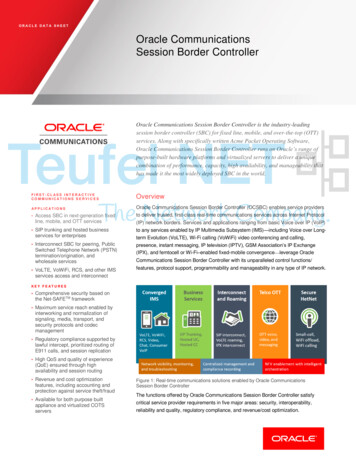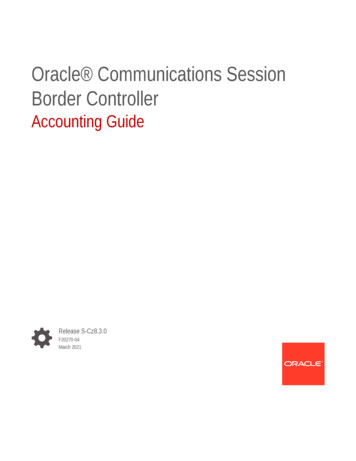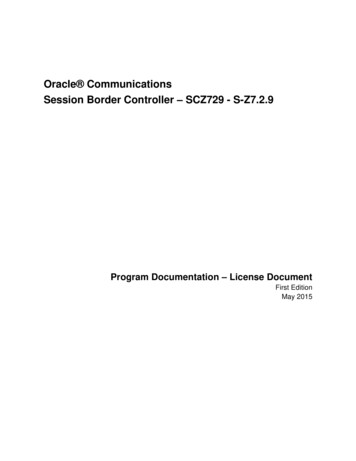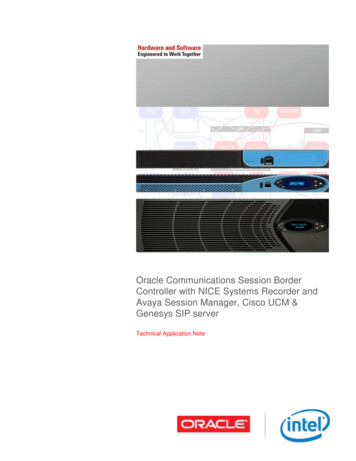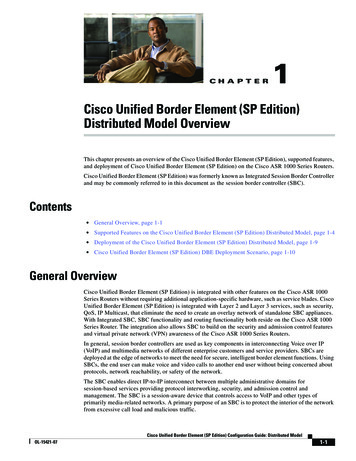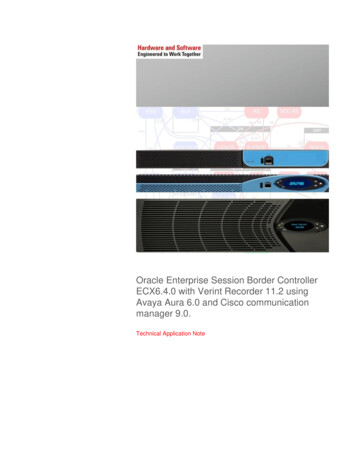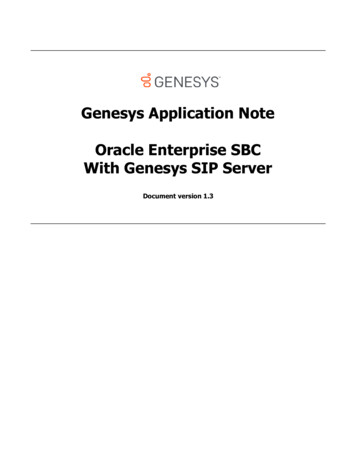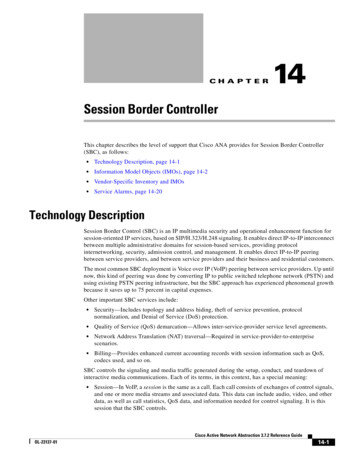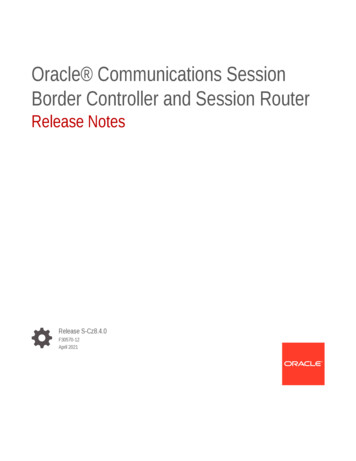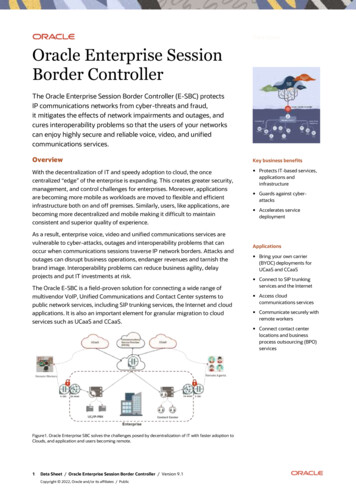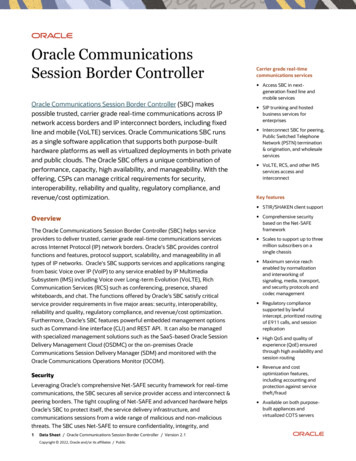
Transcription
Data SheetOracle CommunicationsSession Border ControllerOracle Communications Session Border Controller (SBC) makespossible trusted, carrier grade real-time communications across IPnetwork access borders and IP interconnect borders, including fixedline and mobile (VoLTE) services. Oracle Communications SBC runsas a single software application that supports both purpose-builthardware platforms as well as virtualized deployments in both privateand public clouds. The Oracle SBC offers a unique combination ofperformance, capacity, high availability, and manageability. With theoffering, CSPs can manage critical requirements for security,interoperability, reliability and quality, regulatory compliance, andrevenue/cost optimization.Carrier grade real-timecommunications services Access SBC in nextgeneration fixed line andmobile services SIP trunking and hostedbusiness services forenterprises Interconnect SBC for peering,Public Switched TelephoneNetwork (PSTN) termination& origination, and wholesaleservices VoLTE, RCS, and other IMSservices access andinterconnectKey features STIR/SHAKEN client supportOverviewThe Oracle Communications Session Border Controller (SBC) helps serviceproviders to deliver trusted, carrier grade real-time communications servicesacross Internet Protocol (IP) network borders. Oracle’s SBC provides controlfunctions and features, protocol support, scalability, and manageability in alltypes of IP networks. Oracle's SBC supports services and applications rangingfrom basic Voice over IP (VoIP) to any service enabled by IP MultimediaSubsystem (IMS) including Voice over Long-term Evolution (VoLTE), RichCommunication Services (RCS) such as conferencing, presence, sharedwhiteboards, and chat. The functions offered by Oracle’s SBC satisfy criticalservice provider requirements in five major areas: security, interoperability,reliability and quality, regulatory compliance, and revenue/cost optimization.Furthermore, Oracle’s SBC features powerful embedded management optionssuch as Command-line interface (CLI) and REST API. It can also be managedwith specialized management solutions such as the SaaS-based Oracle SessionDelivery Management Cloud (OSDMC) or the on-premises OracleCommunications Session Delivery Manager (SDM) and monitored with theOracle Communications Operations Monitor (OCOM).SecurityLeveraging Oracle’s comprehensive Net-SAFE security framework for real-timecommunications, the SBC secures all service provider access and interconnect &peering borders. The tight coupling of Net-SAFE and advanced hardware helpsOracle’s SBC to protect itself, the service delivery infrastructure, andcommunications sessions from a wide range of malicious and non-maliciousthreats. The SBC uses Net-SAFE to ensure confidentiality, integrity, and1Data Sheet / Oracle Communications Session Border Controller / Version 2.1Copyright 2022, Oracle and/or its affiliates / Public Comprehensive securitybased on the Net-SAFEframework Scales to support up to threemillion subscribers on asingle chassis Maximum service reachenabled by normalizationand interworking ofsignaling, media, transport,and security protocols andcodec management Regulatory compliancesupported by lawfulintercept, prioritized routingof E911 calls, and sessionreplication High QoS and quality ofexperience (QoE) ensuredthrough high availability andsession routing Revenue and costoptimization features,including accounting andprotection against servicetheft/fraud Available on both purposebuilt appliances andvirtualized COTS servers
availability of real-time interactive communications services. It preempts attacks,eliminates vulnerabilities, and applies powerful mitigation to counteract eventsas they happen, while ensuring continuity and high quality for subscribers andoperators using the services.Performance, capacity, and scalabilityThe Oracle SBC portfolio consists of a wide range of appliances that scale byperformance, capacity, and price point. The virtual offering scales through theinclusion of additional compute, storage, and network resources to a singleinstance. Additional scalability can be achieved by clustering appliances, virtualinstances, or a combination of both by front ending the SBC cluster with eitherthe Oracle’s Session Router or the Subscriber-Aware Load Balancer. AdditionalSBCs can be added seamlessly to existing clusters.Reliability and qualityThe Oracle SBC plays a critical role in ensuring service availability and userquality of experience. It performs admission control via local policies or externalpolicy servers to ensure that both the network and service infrastructure havethe capacity to support high-quality communications. It also monitors andreports actual session quality to determine compliance with performancespecifications set forth in service-level agreements (SLAs) between serviceproviders. Intelligent session routing and high-availability configurationsminimize outages caused by upstream link failure or equipment problems.Revenue and cost optimizationThe Oracle SBC helps service providers control costs and increase revenues withoptions for integrating many IMS functions—routing sessions optimally tominimize costs, providing accounting and related mechanisms to maximizebillable sessions, and protecting against theft of bandwidth and quality of service(QoS). Oracle’s SBC delivers the performance, capacity and throughput neededfor any type and size of service provider. Leveraging state-of-the-art hardwarewith symmetrical multiprocessing across a purpose-built platform family, anOracle SBC scales to support up to three million subscribers on a single chassisand it can support massively scalable access networks operating in an SBCcluster controlled by Oracle Communications Subscriber-Aware Load Balancer(SLB).Oracle Session Border Controller rich feature setSTIR/SHAKENThe STIR/SHAKEN framework, an industry-standard caller ID authenticationtechnology, is a set of technical standards and protocols that allow for theauthentication and verification of caller ID information for calls carried overInternet Protocol (IP) networks.To support STIR/SHAKEN, the Oracle SBC implements a STIR/SHAKEN RESTclient, which, upon receiving an initial out-of-dialog SIP INVITE, sends a RESTrequest to a STIR server for attestation or verification of the calling party2Data Sheet / Oracle Communications Session Border Controller / Version 2.1Copyright 2022, Oracle and/or its affiliates / PublicKey benefits Runs as a single softwareapplication that supportsboth Acme Packet platformsas well as virtualizeddeployments, enablingeasier, seamless adoption ofvirtualization Comprehensive signaling,programmability, and controlfunctions and features withAcme Packet OperatingSoftware Range of platforms toprovide operators a broadarray of price/performancepoints helping them to utilizewhat matches their needs Advanced hardware foroffloading of criticalfunctions such astranscoding and security soas not to impact orcompromise a user’stargeted application of thebase platforms Symmetrical Multiprocessing (SMP) technologyhelps operators to make aninvestment today that isdesigned to meet currentand future networkperformance demands Full IMS integrationcombined with legacy SBCfeature sets on a singlesystem allows gradual usermigration to IMS and LTEnetworks Clustering for carrier gradeperformance, capacity, andavailability
identification. It also provides support to evaluate, track and troubleshootoperations based on extended STIR/SHAKEN client statistics.Architectural flexibilityThe Oracle SBC can be configured as an Access SBC (A-SBC), Interconnect SBC(I-SBC), or both roles simultaneously depending on service requirements. Theflexibility of Oracle’s SBC extends to smaller service providers wishing toconsolidate access and interconnect functionality in a single system. The OracleSBC also integrates standard IMS functions used at access or interconnectborders, simplifying its integration with that next-generation service deliveryarchitecture.At service provider access borders (the borders facing enterprise locations, aswell as public access networks such as the internet, 3G/4G/5G mobile, or fixedline networks used by residential or cable subscribers), the Oracle SBC enablesnew service build-out and consolidation of service infrastructure. It protects theservice delivery infrastructure from malicious and equally dangerousnon-malicious threats while maximizing service reach, reliability, and user qualityof experience. At interconnect borders (the borders between service providernetworks), the SBC accelerates initial offering or expansion of next-generationIMS or IP services, which helps drive down time-division multiplexing (TDM)costs and expand service provider partnerships. The Oracle SBC delivers keyfunctions for service provider interconnects such as highly scalable and flexiblerouting as well as hardware-accelerated security and transcoding.Network session delivery andcontrol infrastructureOracle’s network sessiondelivery and controlinfrastructure helps enterprisesand service providers tomanage the many challenges inthe delivery of IP voice, video,and data services andapplications. Service providersolutions are deployed atnetwork borders and in the IPservice core to help fixed-line,mobile, wholesale, and overthe-top service providersoptimize revenues and realizelong-term cost savings. In theenterprise, session deliveryinfrastructure solutionsseamlessly connect fixed andmobile operators, enabling richmultimedia interactions andautomating business processesfor significant increases inproductivity and efficiency. Thefollowing Oracle products arepart of the network sessiondelivery and controlinfrastructure.Related products Oracle CommunicationsSession Border Controller Oracle CommunicationsSession Router Oracle CommunicationsSubscriber-Aware LoadBalancer Oracle Communications CoreSession Manager Oracle Enterprise SessionBorder Controller Oracle Session DeliveryManagement Cloud Oracle CommunicationsSession Delivery Manager Oracle CommunicationsOperations Monitor Acme Packet 3900 Acme Packet 3950 Acme Packet 4600 Acme Packet 4900 Acme Packet 6300Figure1. Oracle Communications Session Border Controller can be configured as an Access or InterconnectSBC depending on service requirements.3Data Sheet / Oracle Communications Session Border Controller / Version 2.1Copyright 2022, Oracle and/or its affiliates / Public Acme Packet 6350
Acme Packet operating softwareThe Oracle SBC is based on Acme Packet OS, which delivers comprehensivemultiprotocol signaling, programmability, and control functions and features.The SBC supports all commonly used IP signaling protocols including SIP, SIP-I,SIP-T, Diameter, Message Session Relay Protocol (MSRP), and Real TimeStreaming Protocol (RTSP), helping service providers to extend services to thegreatest number of endpoints, as well as services offered via interconnectborders. Extensive signaling protocol Interworking Function (IWF) helps serviceproviders to consolidate signaling traffic within their networks. This reduces thenumber of required network elements, simplifies management, and reducescapital and operating expenditures. Oracle SBC IWF also allows the integration ofnext-generation SIP with legacy networks and endpoints, maximizing servicerevenues.Oracle’s implementation of SIP offers unmatched interoperability, maturity, andfunctionality, with thousands of production deployments throughout the world.To normalize session signaling between SIP implementations that often featurevendor-specific messages and response codes, the SBC features extensivesignaling programmability. This empowers inspection or modification ofelements within protocol headers or payload, including information found in SIP,Session Description Protocol (SDP), and Diameter headers.The Oracle SBC implements a full SIP back-to-back user agent (B2BUA)approach that divides each session flowing through the SBC into two discretesegments. In this way, the SBC maintains session state with each endpointsimultaneously, empowering the application of a wide range of control functionsover the end-to-end session without modification to either the behavior orconfiguration of either endpoint.Figure 2: Oracle Communications Session Border Controller functions as a back-to-back user agent tomaintain full session state with endpoints and service platforms, perform 7-layer packet inspection, and applyfine-grained controls to session traffic at wire rateCertified for Microsoft Teams Direct Routing and support for OperatorConnectOracle’s SBC supports a carrier model that uses Direct Routing to serve multipletenants on a single SBC. This solution uses a single base domain owned by thecarrier and multiple subdomains for each customer, interconnecting betweenhosted PBX systems, multiple third party PSTN and PBXs, and the MicrosoftPhone System.With this model each tenant does not need to implement their own SBC and canreceive telephony services from the carrier in the Teams client. The serviceprovider deploys and manages the SBC to interconnect multiple tenants, providePSTN services, manage end to end call quality, fulfil the regulatory requirements4Data Sheet / Oracle Communications Session Border Controller / Version 2.1Copyright 2022, Oracle and/or its affiliates / Public
(emergency call, lawful intercept) and can charge separately for the PSTNservices it provides.Operator Connect aims to further enhance and simplify voice communications.By creating a new marketplace with most major carriers, Microsoft can enableoperators to provide a managed service for their enterprise customers. As part ofthe implementation, Microsoft Operator Connect requires service providers tohave Session Border Controller (SBC) certified for Direct Routing.Through Direct Routing or Operator Connect, organizations can easily integratetelephony into Microsoft Teams. Oracle SBCs are Microsoft Teams certified forDirect Routing and also support Operator Connect.InteroperabilitySIP interworking capabilities of Oracle’s SBC are designed to maximize servicereach by ensuring interoperability with and between subscriber endpoints, softswitches, IMS Call Session Control Function (CSCF) elements, application servers,media and recording servers, media gateways, and SBCs in peering andenterprise networks. The Oracle SBC enables sessions traverse network addresstranslation (NAT) and firewalls, IPv4 or IPv6 networks, public and privatenetworks using overlapping IP addresses, and virtual private networks (VPNs).Oracle’s SBC mediates between different signaling, transport, and encryptionprotocols; converts incompatible codecs; and translates signaling-layertelephone numbers, addresses, and response codes.Full IMS/next generation network integrationThe Oracle SBC offers full IMS functionality at access and interconnect bordersto fully control the SIP, Real-time Transport Protocol (RTP), and Message SessionRelay Protocol (MSRP) traffic flows that comprise IMS sessions. At IMS accessborders, the SBC implements signaling and media related IMS functions such asProxy Call Session Control Function (P-CSCF), Emergency Access TransferFunction (EATF), Break-out Gateway Control Function (BGCF), Access Gateway(AGW), Access Transfer Control Function (ATCF), and Access Transfer Gateway(ATGW). IMS I-SBC functions include Interconnect Border Control Function (IBCF), IWF, and Interconnect Border Gateway Function (I-BGF)/TranslationGateway (TrGW).Highly scalable platforms and SBC clusteringOracle SBC operates on a wide range of platforms that leverage the richfunctionality of Acme Packet OS. Oracle’s SBC Platforms feature high availability,carrier grade manageability, and redundancy for uncompromised quality,interoperability, and security.When deployed in conjunction with Oracle Communications Subscriber-AwareLoad Balancer, the Oracle SBC can also function as a member of an SBC cluster.SBC clusters provide dynamic, adaptive load balancing of subscriber trafficacross the cluster, allowing services to scale to support millions of subscriberswithout architectural forklifts or network disruptions. SBC clusters also deliverenhanced redundancy and manageability not achievable with traditional loadbalancers or SIP redirect servers.5Data Sheet / Oracle Communications Session Border Controller / Version 2.1Copyright 2022, Oracle and/or its affiliates / Public
Figure 3. Oracle Communications Subscriber-Aware Load Balancer enables formation of SBC clusters forenhanced scalability.SBC virtualizationThe Oracle SBC may be run as a Virtual Network Function (VNF). Supportedhypervisors for the Oracle SBC VNF include Kernel-Based Virtual Machine (KVM),and VMware ESXi. The Oracle SBC supports HEAT templates for improvedautomation and Virtual Machine (VM) instantiation which can be used inNetwork Function Virtualization (NFV) and Cloud deployments with OpenStack.As a VNF, the Oracle SBC may be deployed as a standalone instance or within anorchestrated virtual environment, and offers the same level of functionality,security, interoperability, and reliability as it does on purpose-built platforms.Instances of virtualized SBCs may be clustered with their counterparts onpurpose-built platforms, creating what are known as “hybrid clusters”, providinga way for their gradual introduction and for even greater deployment flexibilityand network agility.Supporting a virtualized function in a public cloud requires meeting specialrequirements. Public clouds have very specific guidelines such as IP addressingusage, hypervisor selection and I/O mode to provide security and integrity for allits tenets. The Oracle SBC software supports deployment in Oracle CloudInfrastructure (OCI) and Amazon Web Services (AWS) public clouds in highlyavailable (HA) mode. The Oracle SBC can also be deployed in Microsoft Azurepublic cloud in Standalone mode.Management and orchestration (MANO)Oracle Communications offers VNFs for session management, service deliveryplatforms including SBCs, load balancing, core network signaling managementand policy management. Oracle’s strategy is based on providing carrier gradeVNFs that can be orchestrated in a flexible manner by a variety of environments,including the major industry orchestration and automation third party offeringsas well as solutions based on frameworks, such as ONAP, OSM, and OpenStackTacker.The Oracle SBC supports REST API to enable zero-touch instantiation, remoteconfiguration and monitoring of SBC VNFs and facilitates multivendor6Data Sheet / Oracle Communications Session Border Controller / Version 2.1Copyright 2022, Oracle and/or its affiliates / Public“At Evolve IP, we arecommitted toevolving our network,positioning ourselvesto support theanticipated trafficgrowth and valueadded services ourcustomers willrequire in the future.It is clear to us thatmoving to the cloudwill be critical inmeeting these goals.We see Oracle as anexpert in cloud,virtualization, IT, andtelecommunicationsand have found thatits OracleCommunications SBCoffers uniquestrengths in all ofthese areas.”Michiel van DisManaging DirectorEvolve IP Europe
interoperability and predictable behavior based well defined standards andspecifications.Oracle SBC key functions and featuresFUNCTIONAL AREASBC FUNCTIONS/FEATURESGeneral Session Initiation Protocol (SIP): user interface or back-to-back useragent (B2BUA)Message Session Relay Protocol (MSRP)DNS: application layer gateway (ALG)IMS/NGN support Proxy Call Session Control Function (PCSCF)Serving Policy Decision Function (SPDF)Access/Core Border Gateway Function (A/C-BGF)Access Transfer Control Function (ATCF)Access Transfer Gateway (ATGW)Interconnect Border Control Function (I-BCF)Interworking Function (IWF)Interconnect Border Gateway Function (IBGF)Emergency Access Transfer Function (EATF)Signaling interfaces: Gm, Mw, Ic, IwDiameter interfaces: Rf, Rq, e2, Gq, RxCOPS interfaces: Rq, e2Net-SAFE security SBC denial of service (DoS) self-protectionStatic or dynamic access controls (permit/deny)Self-protection against signaling overloads and distributed denialof service (DDoS) attacksProtection of IMS core from registration overloads and attacksMedia and signaling validation to prevent service theft and fraudDTLS, IPsec, TLS, IMS AKA, and SRTP encryption for privacy andconfidentialitySignaling protocols Interoperability SIP signaling protocol interworking and mediationSIP/SIP-I/SIP-T interworkingSIP IPv6-IPv4 interworkingNAT traversal and IP address mediationSignaling and dial plan normalizationDual Tone Multi-Frequency (DTMF) extractionTranscoding/transrating with flexible, dynamic codec managementMicrosoft Teams Direct RoutingSLA assurance Check-pointing of signaling, media, and configuration for nonstopavailabilityDefine and enforce QoS marking/mappingTraffic and session prioritizationQoS monitoring, accounting, and reportingAdmission controls to maximize service infrastructure availabilityPolicy enforcement to ensure bandwidth availabilitySession reroute around upstream outages Service enablement 7Supported on Oracle’s purpose-built hardware and virtualizedserver platformsA-SBC or I-SBC functionalitySoftware only offering for virtualized platformsHA: signaling, media, configuration checkpointingFlexible routingSIP load balancingStandards-based AAA (ENUM, DNS, Diameter, RADIUS)Protocol interworking to simplify core network trafficDynamic bandwidth monitoring and controlIndustry-standard Session Recording Protocol (SIPREC)3GPP Enhanced Firewall Traversal Function (EFTF), formerly TSCFAccounting with Diameter, RADIUS, and comma-separated value(CSV) file formatsNative REST API for custom configuration and KPI monitoringSupport for orchestration on OCI and AWS using Terraform scriptsData Sheet / Oracle Communications Session Border Controller / Version 2.1Copyright 2022, Oracle and/or its affiliates / Public
Oracle –Supported SBC hardware platforms – Sample P3950AP4600AP4900AP6300AP6350Form factorVirtualized1U System1U System1U System1U System3U System3U SystemSystemArchitectureData Centre/COTSPurpose BuiltPurpose BuiltPurpose BuiltPurpose BuiltPurpose BuiltPurpose BuiltMax. 0,000Max. SRTP ax. ,000Max. TranscodedSessions(G711 - 1001505807001,2001,700Max. Calls PerSecond* VM configuration dependent** Software transcodingMonitoring and managementOracle SBC embedded element management delivers full administrative accessto the command line interface (CLI), Simple Network Management Protocol(SNMP) management information bases (MIBs), statistics, system logs, packettrace information, and system software and configuration files via distinctmanagement interfaces. Third-party management systems and operationsupport systems (OSS)/ business support systems (BSS) applications can alsoleverage Secure File Transfer Protocol (SFTP) and SNMP to access systemaccounting and performance data, MIBs, and historical data records (HDRs).REST API support is also available for configuration and statistics monitoring.Built on Oracle’s next-generation cloud infrastructure, Oracle Session DeliveryManagement Cloud (OSDMC) helps customers minimize operational costs in amore agile, reliable, and secure way. The feature-rich SaaS solution includesfault, configuration, accounting, performance, and security (FCAPS)management, and provides an insightful and unified view across the OracleCommunications Session Delivery products portfolio. Oracle CommunicationsSession Delivery Manager (SDM) is the on-premises solution for FCAPSmanagement across multiple Oracle’s session delivery products. Oracle SDM alsofeatures application add-ons for reporting, SIP trunk provisioning, and SIPsession routing.Oracle Communications Operations Monitor (OCOM) is browser-based real-timenetwork intelligence software that optimizes next-generation IP communicationsnetworks, enables rapid troubleshooting of customer experience issues down tothe individual session level, proactively identifies and isolates communicationsnetwork faults and events, and detects fraudulent network activity. OCOMdelivers end-to-end network visibility to better align network resources with enduser application requirements and improves the performance of end userservices.The Oracle SBC features an internal probe that captures and forwards sessiontraffic at wire rate, helping Oracle Communications Operations Monitor toinstantly display fine-grained real-time communications performance metrics.Since it is integrated with the SBC, the internal probe overcomes limitations ofstandalone external probes by capturing and analyzing encrypted sessions8Data Sheet / Oracle Communications Session Border Controller / Version 2.1Copyright 2022, Oracle and/or its affiliates / Public
without compromising subscriber privacy or confidentiality. The embeddedprobe also analyzes voice quality metrics and reports it to OracleCommunications Operations Monitor.SummaryThe Oracle Communications Session Border Controller (SBC) is a valuablesolution for fixed line, mobile and over-the-top service providers. Oracle’s SBC isbased on a product strategy that is aligned to support the continued growth ofIMS based mobile and fixed broadband services. Via state-of-the art hardwareplatforms, virtualized offerings, industry-leading 3GPP, GSMA, and IETFcompliance, and groundbreaking software enhancements, the Oracle SBC bringsvalue-added solutions through integration with other key Oracle technologiesand helps operators remain innovative and profitable.Connect with usCall 1.800.ORACLE1 or visit oracle.com. Outside North America, find your local office at: acleCopyright 2022, Oracle and/or its affiliates. All rights reserved. This document isprovided for information purposes only, and the contents hereof are subject to changewithout notice. This document is not warranted to be error-free, nor subject to any otherwarranties or conditions, whether expressed orally or implied in law, including impliedwarranties and conditions of merchantability or fitness for a particular purpose. Wespecifically disclaim any liability with respect to this document, and no contractualobligations are formed either directly or indirectly by this document. This documentmay not be reproduced or transmitted in any form or by any means, electronic ormechanical, for any purpose, without our prior written permission.9twitter.com/oracleOracle and Java are registered trademarks of Oracle and/or its affiliates. Other names may betrademarks of their respective owners.Intel and Intel Xeon are trademarks or registered trademarks of Intel Corporation. All SPARCtrademarks are used under license and are trademarks or registered trademarks of SPARCInternational, Inc. AMD, Opteron, the AMD logo, and the AMD Opteron logo are trademarks orregistered trademarks of Advanced Micro Devices. UNIX is a registered trademark of The OpenGroup. 0322Data Sheet / Oracle Communications Session Border Controller / Version 2.1Copyright 2022, Oracle and/or its affiliates / Public
At service provider access borders (the borders facing enterprise locations, as well as public access networks such as the internet, 3G/4G/5G mobile, or fixed line networks used by residential or cable subscribers), the Oracle SBC enables new service build-out and consolidation of service infrastructure. It protects the
